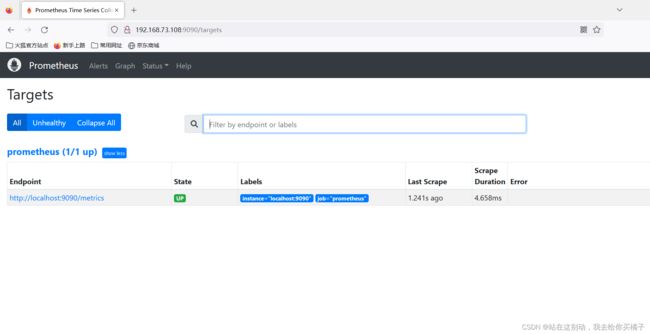【云原生】Prometheus之图形化界面grafana与服务发现部署
内容预知
前言
1. 部署 Grafana
1.1 grafana的下载与安装
(1)安装grafana
(2)配置数据源
(3)导入 grafana 监控面板
(4)删除模板操作
4.2 grafana的中文插件安装
2. 部署 Prometheus 服务发现
2.1 基于文件的服务发现
实验前准备
(1)创建用于服务发现的文件,在文件中配置所需的 target
(2)在载入的文件中添加新的node节点监控
2.2 基于 Consul 的服务发现
(1)部署Consul服务
(2)在consul中注册service
(3)修改 prometheus 配置文件,让Prometheus基于consul进行服务发现
(4)在consul中添加node节点,从而改变Prometheus的监控节点
(5)consul注销与重新注册service
2.3 基于 Kubernetes API 的服务发现
前言
上一篇文章中我们介绍了Prometheus的组件,监控作用,部署方式,以及如何通过在客户机安装exporter再添加监控项的操作。但是不免会发现原生的Prometheus的图像化界面对于监控数据并不能其他很好的展示效果。所以本次我们将介绍一款开源非常适用于Prometheus的图形化软件grafana 。
除此之外,上面的exporter监控项都是通过手动添加,这样效率慢而且需要中止Prometheus的工作进程,所以本次我们将介绍几种让Prometheus自动完成服务发现的方法
1. 部署 Grafana
1.1 grafana的下载与安装
(1)安装grafana
下载地址:https://grafana.com/grafana/download
https://mirrors.bfsu.edu.cn/grafana/yum/rpm/
yum install -y grafana-7.4.0-1.x86_64.rpm
systemctl start grafana-server
systemctl enable grafana-server
netstat -natp | grep :3000
浏览器访问:http://192.168.73.108:3000 ,默认账号和密码为 admin/admin(2)配置数据源
Configuration -> Data Sources -> Add data source -> 选择 Prometheus
HTTP -> URL 输入 http://192.168.73.108:9090
点击 Save & Test
点击 上方菜单 Dashboards,Import 所有默认模板
Dashboards -> Manage ,选择 Prometheus 2.0 Stats 或 Prometheus Stats 即可看到 Prometheus job 实例的监控图像
(3)导入 grafana 监控面板
浏览器访问:https://grafana.com/grafana/dashboards ,在页面中搜索 node exporter ,选择适合的面板,点击 Copy ID 或者 Download JSON
在 grafana 页面中,+ Create -> Import ,输入面板 ID 号或者上传 JSON 文件,点击 Load,即可导入监控面板
(4)删除模板操作
4.2 grafana的中文插件安装
1、备份public目录
mv /usr/share/grafana/public /usr/share/grafana/public.source
2、备份/usr/sbin/grafana-server和grafana-cli
cp /usr/sbin/grafana-server /usr/sbin/grafana-server.source
cp /usr/sbin/grafana-cli /usr/sbin/grafana-cli.source
3、进入grafana-chinese目录 停止grafana服务,拷贝grafana/bin/linux-amd64/grafana-server 和 grafana-cli /usr/sbin目录
systemctl stop grafana-server
/bin/cp -rp bin/linux-amd64/grafana-server /usr/sbin/
/bin/cp -rp bin/linux-amd64/grafana-cli /usr/sbin/
4、拷贝grafana/public 到 /usr/share/grafana/
/bin/cp -rp public /usr/share/grafana/
5、启动grafana-server
systemctl start grafana-server
2. 部署 Prometheus 服务发现
2.1 基于文件的服务发现
基于文件的服务发现是仅仅略优于静态配置的服务发现方式,它不依赖于任何平台或第三方服务,因而也是最为简单和通用的实现方式。
Prometheus Server 会定期从文件中加载 Target 信息,文件可使用 YAML 和 JSON 格式,它含有定义的 Target 列表,以及可选的标签信息。
实验前准备
将就手动添加的监控项清除。
(1)创建用于服务发现的文件,在文件中配置所需的 target
cd /usr/local/prometheus
mkdir targets
vim targets/node-exporter.yaml
- targets:
- 192.168.73.105:9100
- 192.168.73.106:9100
labels:
app: node-exporter
job: node
#修改 prometheus 配置文件,发现 target 的配置,定义在配置文件的 job 之中
vim /usr/local/prometheus/prometheus.yml
......
scrape_configs:
- job_name: nodes
file_sd_configs: #指定使用文件服务发现
- files: #指定要加载的文件列表
- targets/node*.yaml #文件加载支持通配符
refresh_interval: 2m #每隔 2 分钟重新加载一次文件中定义的 Targets,默认为 5m
systemctl reload prometheus(2)在载入的文件中添加新的node节点监控
2.2 基于 Consul 的服务发现
Consul 是一款基于 golang 开发的开源工具,主要面向分布式,服务化的系统提供服务注册、服务发现和配置管理的功能。提供服务注册/发现、健康检查、Key/Value存储、多数据中心和分布式一致性保证等功能。
下载地址:https://www.consul.io/downloads/
(1)部署Consul服务
mkdir -p /opt/prometheus/consul
cd /opt/prometheus/consul
unzip consul_1.9.2_linux_amd64.zip
mv consul /usr/local/bin/
#创建 Consul 服务的数据目录和配置目录
mkdir /var/lib/consul-data
mkdir /etc/consul/
#使用 server 模式启动 Consul 服务
consul agent \
-server \
-bootstrap \
-ui \
-data-dir=/var/lib/consul-data \
-config-dir=/etc/consul/ \
-bind=192.168.73.108 \
-client=0.0.0.0 \
-node=consul-server01 &> /var/log/consul.log &
#查看 consul 集群成员
consul members(2)在consul中注册service
#在配置目录中添加文件
vim /etc/consul/nodes.json
{
"services": [
{
"id": "node_exporter-node01",
"name": "node01",
"address": "192.168.73.106",
"port": 9100,
"tags": ["nodes"],
"checks": [{
"http": "http://192.168.73.106:9100/metrics",
"interval": "5s"
}]
},
{
"id": "node_exporter-node02",
"name": "node02",
"address": "192.168.73.107",
"port": 9100,
"tags": ["nodes"],
"checks": [{
"http": "http://192.168.73.107:9100/metrics",
"interval": "5s"
}]
}
]
}
#让 consul 重新加载配置信息
consul reload
浏览器访问:http://192.168.73.108:8500(3)修改 prometheus 配置文件,让Prometheus基于consul进行服务发现
(3)修改 prometheus 配置文件
vim /usr/local/prometheus/prometheus.yml
......
- job_name: nodes
consul_sd_configs: #指定使用 consul 服务发现
- server: 192.168.73.108:8500 #指定 consul 服务的端点列表
tags: #指定 consul 服务发现的 services 中哪些 service 能够加入到 prometheus 监控的标签
- nodes
refresh_interval: 2m
systemctl reload prometheus
浏览器查看 Prometheus 页面的 Status -> Targets(4)在consul中添加node节点,从而改变Prometheus的监控节点
vim /etc/consul/nodes.json
{
"services": [
{
"id": "node_exporter-node01",
"name": "node01",
"address": "192.168.73.106",
"port": 9100,
"tags": ["nodes"],
"checks": [{
"http": "http://192.168.73.106:9100/metrics",
"interval": "5s"
}]
},
{
"id": "node_exporter-node02",
"name": "node02",
"address": "192.168.73.107",
"port": 9100,
"tags": ["nodes"],
"checks": [{
"http": "http://192.168.73.107:9100/metrics",
"interval": "5s"
}]
},
########向consul中新添加的master节点##################
{
"id": "node_exporter-master01",
"name": "node02",
"address": "192.168.73.105",
"port": 9100,
"tags": ["nodes"],
"checks": [{
"http": "http://192.168.73.105:9100/metrics",
"interval": "5s"
}]
}
]
}
#让 consul 重新加载配置信息
consul reload
(5)consul注销与重新注册service
#让 consul 注销 Service
consul services deregister -id="node_exporter-node02"
#重新注册
consul services register /etc/consul/nodes.json2.3 基于 Kubernetes API 的服务发现
基于 Kubernetes API 的服务发现机制,支持将API Server 中 Node、Service、Endpoint、Pod 和 Ingress 等资源类型下相应的各资源对象视作 target, 并持续监视相关资源的变动
●Node、Service、Endpoint、Pod 和 Ingress 资源分别由各自的发现机制进行定义
●负责发现每种类型资源对象的组件,在 Prometheus 中称为一个 role
●支持在集群上基于 DaemonSet 控制器部署 node-exporter 后发现各 Node 节点,也可以通过 kubelet 来作为 Prometheus 发现各 Node 节点的入口
#基于 Kubernetes 发现机制的部分配置参数
# The API server addresses. If left empty, Prometheus is assumed to run inside of the cluster and will discover API servers automatically
and use the pod's
# CA certificate and bearer token file at /var/run/secrets/kubernetes.io/serviceaccount/.
[ api_server: ]
# The Kubernetes role of entities that should be discovered. One of endpoints, service, pod, node, or ingress.
role:
# Optional authentication information used to authenticate to the API server.
# Note that 'basic_auth', 'bearer_token'和'bearer_token_file' 等认证方式互斥;
[ bearer_token: ]
[ bearer_token_file: ]
# TLS configuration.
tls_config:
# CA certificate to validate API server certificate with.
[ ca_file: ]
# Certificate and key files for client cert authentication to the server.
[ cert_file: ]
[ key_file: ]
# ServerName extension to indicate the name of the server.
[ server_name: ]
# Optional namespace discovery. If omitted, all namespaces are used.
namespaces:
names:
[ - ]





























